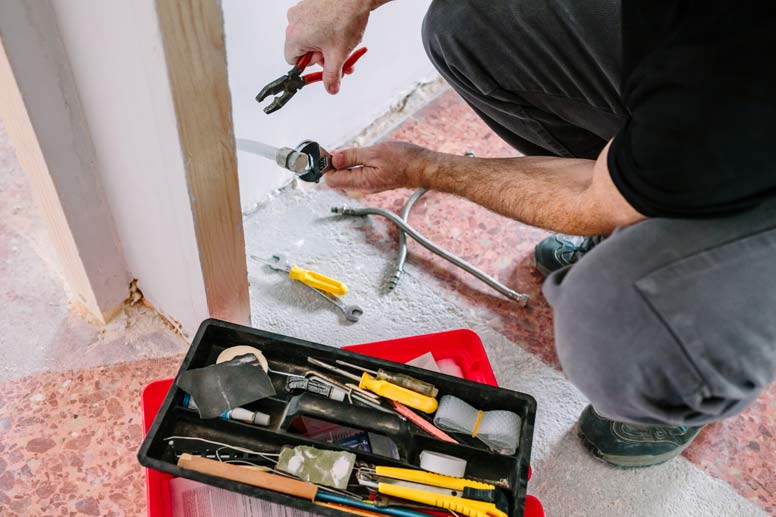How To Price Jobs as a Handyman: Step-by-Step Guide

Table of Contents
- Hourly Rate vs. Flat Rate: Which Is Right for You?
- Don’t Forget Your Expenses
- Know What Competitors Are Charging
- How To Charge Handyman Jobs by State:
- How Experience Affects Pricing
- Estimate Your Time Wisely
- Other Factors That Impact Pricing Handyman Jobs
- Use Discounts and Upsells Strategically
- Price Formula to Cover Costs and Ensure Profit
- Final Thoughts
Figuring out how to price handyman or handyperson jobs can feel like a guessing game at first, but it’s one of the most critical steps in running a successful, profitable business.
The right pricing ensures you make money, stay competitive, and avoid overworking yourself. Whether you’re starting a new handyman business or fine-tuning your pricing strategy, this guide is here to help.
Let’s break down everything you need to know so you can set your prices with confidence and make your business work for you.
Hourly Rate vs. Flat Rate: Which Is Right for You?
First things first—how do you decide between an hourly rate and a flat rate? Most handyman businesses use a mix of both, and each has its benefits.
Hourly Rate
Charging by the hour works well when you’re not sure how long a job will take. Hourly pricing also allows you to be flexible with clients who have long task lists.
You can move from one job to the next without renegotiating prices. This way, you get paid fairly even if unexpected issues arise. For instance:
- You charge $70/hour to fix a door. What seems like a simple adjustment turns into a larger project when you find damage to the frame. With an hourly rate, you’re covered for the extra time.
Flat Fee
Flat rates appeal to clients who want a clear, upfront cost and work best for predictable tasks or when your experience helps you complete jobs quickly. Flat rates also build trust with clients, as they know exactly what to expect.
This pricing model is perfect for jobs like furniture assembly, mounting TVs, or gutter cleaning. For example:
- You charge $150 flat to replace a faucet. If the job only takes 1.5 hours, you earn more than if you charged an hourly rate of $70.
Pro Tip: Why not mix and match? Use hourly rates for complex or open-ended tasks and flat rates for straightforward ones. This flexibility keeps both you and your clients happy.

Don’t Forget Your Expenses
Your pricing needs to cover more than just your time—it should also account for the costs of running your business. Missing this step can leave you working hard without making a profit.
What to Include
- Job Expenses: Tools, materials, fuel, and any other direct costs.
- Overhead Costs: Ongoing expenses like insurance, marketing, software, vehicle maintenance, or even language classes.
For instance:
- If your monthly overhead is $3,000 and your direct job costs average $2,000, your base pricing must cover $5,000 in expenses before you factor in profits.
Quick Tip: Use a Receipt Scanner to track these expenses and ensure you’re not leaving anything out.
Know What Competitors Are Charging
Want to know if your rates are reasonable? Check out what others in your area charge for similar services. Set your rates based on local market trends and what you bring to the table. This can help you find that sweet spot where you’re not overpricing or undervaluing your work.
How to Research:
- Look at online platforms.
- Check handyman websites and social media.
- Talk to others in your network.
- Ask clients what they’ve been quoted for similar jobs.
How To Charge Handyman Jobs by State:
Rates can vary a lot depending on where you are. Regional differences reflect factors like cost of living, demand, and competition.
For example:
- California: $80–$120/hour
- Texas: $50–$75/hour
- Florida: $40–$65/hour

How Experience Affects Pricing
The more experienced you are, the more you can charge. If you’re just starting out, you might need to price a little lower to attract clients. But as you build your reputation, don’t be afraid to raise your rates—clients are often willing to pay more for someone reliable and experienced.
For example, A new handyman might charge $50/hour to gain experience. A pro with a solid client base can charge $90/hour or more, especially for specialized work.
Estimate Your Time Wisely
Time is money, so estimating how long a job will take is key to accurate pricing. Overestimating might scare clients away, while underestimating can cut into your profits.
Tips for Accurate Estimates
- Break the job into smaller tasks and estimate each one.
- Add a buffer for unexpected delays or complications.
- Use Time Tracking Software to monitor your hours and refine your estimates over time.
Example:
If replacing a faucet usually takes two hours, add 30 minutes for setup and cleanup. This way, you’re covered even if something unexpected comes up.
Other Factors That Impact Pricing Handyman Jobs
Pricing isn’t one-size-fits-all. Tailoring your prices to these factors helps ensure you’re paid fairly for your time and effort:
- Seasonal Demand: Charge more during busy times, like spring and fall when people tackle home improvement projects.
- Emergency Services: Add a premium for after-hours or last-minute calls.
- Complexity: Specialized tasks or ones requiring niche skills (like carpentry or tiling) should cost more.
- Client Type: Commercial clients, such as property managers or businesses, often pay higher rates than homeowners.
Use Discounts and Upsells Strategically
Offering discounts can help you attract new clients or fill slow periods, but it’s important to do so strategically. These strategies make your services more appealing without cutting into your profits:
Group Discounts
Encourage neighbors to book your services together by offering a small discount for multiple jobs in the same area. For example:
- Offer 10% off for three or more clients on the same block. This minimizes your travel time while maximizing your earnings.
Service Packages
Bundle related services to add value and boost your revenue. For instance:
• Offer gutter cleaning and pressure washing as a discounted package.

Price Formula to Cover Costs and Ensure Profit
To set your pricing, start with your expenses and add a profit margin. Here’s a simple formula:
(Expenses + Labor Costs) × Profit Margin = Price
Example Calculation
- Monthly expenses: $5,000
- Estimated monthly hours: 160
- Base hourly rate: $31.25/hour
- Desired profit margin: 25%
Final hourly rate:
$31.25 × 1.25 = $39.06/hour
For flat rates, multiply your hourly rate by the estimated hours for the job, then add any material costs.
Pro Tip: Streamline this process with the Quote Generator for quick, professional quotes.
Final Thoughts
Learning how to price handyman jobs effectively can set you apart from the competition, attract loyal clients, and grow your business. By balancing your expenses, time, and expertise with market trends, you’ll find the perfect pricing sweet spot.
Start simplifying your workflow today with Invoice Fly Handyman Software—and watch your business thrive!
